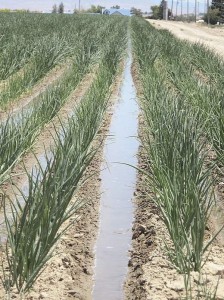From the U.S. Government Accountability Office:
Although the United States has one of the safest food supplies in the world, foodborne illness is a common public health problem. Some of this illness can be linked to produce. In 2006, for example, an E. coli outbreak associated with baby spinach sickened 205 people and killed 3; in 2011, 147 people fell ill and 33 died as a result of eating melons contaminated with Listeria. Other produce-related outbreaks in recent years have involved cucumbers, alfalfa sprouts, bean sprouts, and packaged salads.
 The Food and Drug Administration (FDA), an agency within the Department of Health and Human Services (HHS), has responsibility for ensuring the safety of produce, along with many other foods. Overall, FDA is responsible for ensuring the safety of more than 80 percent of the U.S. food supply.
The Food and Drug Administration (FDA), an agency within the Department of Health and Human Services (HHS), has responsibility for ensuring the safety of produce, along with many other foods. Overall, FDA is responsible for ensuring the safety of more than 80 percent of the U.S. food supply.
Because produce is often consumed raw without processing to reduce or eliminate contaminants, preventing contamination is key to ensuring safe consumption. In January 2011, the FDA Food Safety Modernization Act (FSMA) was signed into law, representing the largest expansion and overhaul of U.S. food safety law since the 1930s.1 FSMA, according to FDA, marked a historic turning point by focusing on preventing rather than reacting to foodborne illnesses. FSMA did so, in part, by requiring FDA to promulgate new rules that together provide a framework for industry to implement preventive measures and for FDA to oversee implementation. In response to FSMA, FDA developed seven foundational rules; among them was the rule entitled Standards for the Growing, Harvesting, Packing, and Holding of Produce for Human Consumption—widely referred to as the produce safety rule.2 This rule, which FDA promulgated in November 2015, established the first enforceable national standards for on-farm growing, harvesting, packing, and holding of domestic and imported produce.3 Among other things, the rule established standards related to agricultural water quality; the use of soil amendments, such as raw manure; the presence of domesticated and wild animals; worker training, health, and hygiene; and sanitation of equipment, tools, and buildings. The rule includes staggered compliance dates depending on average annual produce sales of a business and other factors. For example, compliance for some of the largest businesses comes due beginning in 2017 and 2018, while compliance for certain smaller businesses is not due until 2020. FDA has been developing guidance and training for those affected by the new standards under the produce rule; the agency has also set aside funding for states to help them support implementation of the rule. In addition, the agency is hiring experts with backgrounds in science and policy to work in different regions of the country assisting state officials with implementation of the rule, according to FDA officials.
Some in the produce industry have expressed concerns about the new produce rule standards, including concerns about the scientific basis for standards in such areas as water quality. Some have also expressed concerns about the costs associated with meeting the new standards, particularly for smaller businesses. The Agricultural Act of 2014, also referred to as the 2014 Farm Bill, required that FDA ensure the final produce rule include “a plan to systematically…develop an ongoing process to evaluate and respond to business concerns.”4
The act included a provision for GAO to report, 1 year after the promulgation of the final produce rule and again the next year, on the ongoing evaluation and response process. This first report examines (1) how FDA evaluates and responds to business concerns regarding the produce rule and (2) how FDA plans to assess the effectiveness of its efforts to evaluate and respond to business concerns regarding the rule.5
 To examine how FDA evaluates and responds to business concerns regarding the produce rule, we reviewed the final rule, including FDA’s responses to public comments on the rule; reviewed relevant information on FSMA and the produce rule on FDA’s website; interviewed FDA officials involved in implementation of the rule; and interviewed representatives from two organizations assisting FDA with implementation of the rule.6 We also interviewed representatives from six produce industry associations and one large retailer for their views on any FDA efforts to respond to business concerns.7 We selected industry associations with large memberships, those representing both large and small businesses, and those representing differing types of produce. These interviews provided a sampling of views and are not generalizable to all produce industry associations, businesses, or others affected by the produce rule. To determine how FDA plans to assess the effectiveness of its efforts to evaluate and respond to business concerns, we interviewed FDA officials to learn about any ongoing or planned efforts.
To examine how FDA evaluates and responds to business concerns regarding the produce rule, we reviewed the final rule, including FDA’s responses to public comments on the rule; reviewed relevant information on FSMA and the produce rule on FDA’s website; interviewed FDA officials involved in implementation of the rule; and interviewed representatives from two organizations assisting FDA with implementation of the rule.6 We also interviewed representatives from six produce industry associations and one large retailer for their views on any FDA efforts to respond to business concerns.7 We selected industry associations with large memberships, those representing both large and small businesses, and those representing differing types of produce. These interviews provided a sampling of views and are not generalizable to all produce industry associations, businesses, or others affected by the produce rule. To determine how FDA plans to assess the effectiveness of its efforts to evaluate and respond to business concerns, we interviewed FDA officials to learn about any ongoing or planned efforts.
We conducted this performance audit from August 2016 to November 2016 in accordance with generally accepted government auditing standards. Those standards require that we plan and perform the audit to obtain sufficient, appropriate evidence to provide a reasonable basis for our findings and conclusions based on our audit objectives. We believe that the evidence obtained provides a reasonable basis for our findings and conclusions based on our audit objectives.
FDA has developed an information clearinghouse to evaluate and respond to concerns from businesses and other stakeholders regarding any of the FSMA rules, including the produce rule. Operational since September 2015, this clearinghouse, called the Technical Assistance Network (TAN), serves as a central source of information to support understanding and implementation of the FSMA rules. Businesses and other stakeholders—such as industry associations, academia, and consumers—can submit questions online or by phone or traditional mail. Phase 1 of the TAN, which is currently operational, evaluates and responds to questions related to the publication of FSMA rules. Phase 2, which FDA expects to begin in 2017, will evaluate and respond to questions from FDA and state inspectors working to ensure industry compliance with FSMA rules. FDA officials we interviewed told us the agency intends to maintain the TAN as a mechanism to respond to stakeholder questions and concerns even after the produce rule and other FSMA rules are fully implemented.8
We examined FDA data on TAN questions received by the agency from early September 2015 through early September 2016.9 During that period, FDA received 2,626 TAN questions, most of which had been submitted online.10 About 14 percent of questions (363) pertained to the produce rule, and about 60 percent of questions (218) pertaining to the produce rule came from those who identified as belonging to “industry/business.”11 According to FDA, the agency tracks TAN questions to help inform FSMA policy, guidance, and training. For example, officials at FDA told us that many of the questions it received related to the produce safety rule sought clarification regarding uses of water that meet the definition of “agricultural water.” FDA also received many questions seeking clarification on the requirements for collecting samples of agricultural water. Because of the large number of questions on both of these topics, FDA considers them high-priority areas to address in developing guidance. Specifically, FDA identified these topics as those most important to include in the first phase of its general compliance and implementation guidance for the produce rule, whereas other topics will be addressed in the second phase of the guidance.
In addition to addressing business concerns through the TAN, FDA officials told us they will continue to reach out to industry during produce rule implementation, just as they did while developing the rule. For example, FDA officials plan to meet with industry as they develop guidance documents, which provide direction on complying with produce rule standards. According to these officials, the guidance development process will provide another opportunity to hear and respond to business concerns. FDA may incorporate industry suggestions into the final guidance, as appropriate. Representatives from industry associations we interviewed generally praised FDA’s level of collaboration during the rulemaking process, noting that FDA had been willing to engage with them and address their concerns.12
FDA Is Developing a Survey and Other Metrics to Assess Its Information Clearinghouse
FDA officials we interviewed said the agency is developing a stakeholder survey to assess the effectiveness of its information clearinghouse, the TAN. FDA will send a copy of the survey to businesses and other stakeholders when providing responses to TAN questions submitted online. Most TAN questions are submitted online. Officials told us surveys will be sent starting in fiscal year 2017, after the required Office of Management and Budget (OMB) review is complete.13 FDA plans to implement the survey in two parts, according to officials. The first part will begin in early fiscal year 2017 and will solicit feedback from stakeholders about the web page FDA provides for submitting questions online. In late fiscal year 2017, FDA will begin soliciting feedback about the quality of information the agency provided in its responses to TAN questions. In addition, officials said the agency is developing metrics to measure overall success in implementing the produce rule and plans to begin using these metrics in January 2018, when compliance with most of the produce rule standards comes due for most large businesses. These metrics will be used to examine how effective the TAN is in responding to questions and will ultimately be used to assess whether additional training and outreach to business are needed to help implement the produce rule.
We asked representatives from industry associations and other organizations we interviewed about their experiences submitting questions to the TAN. These representatives generally told us that wait times for answers from the TAN can be long, and some had not yet received answers to their questions. For example, representatives from one industry association told us it took 4 months to get an answer through the TAN.
FDA officials told us that, as of early October 2016, the agency had responded to about 72 percent of all TAN questions received. Officials said FDA is currently studying how long it takes, on average, to respond to questions submitted to the TAN, and the agency is working to decrease its response time. Also, according to FDA officials, response times to TAN questions may be longer in some cases because agency guidance on the produce rule and other FSMA rules is still under development, and the agency does not want to provide information through the TAN that might conflict with the subsequent guidance. In addition, officials said that while simpler questions can often be addressed immediately by FDA staff that monitor the TAN, about 95 percent of the questions are more complex. These questions are forwarded to subject matter experts within the agency and, consequently, require more time for a response. According to FDA, median response time for questions forwarded to subject matter experts is 22 business days. FDA officials told us that if a question is still unaddressed after 30 days, FDA will send an automated message saying the agency is working on a response; a second automated message is sent after 60 days if the question is still unresolved.
 Since 2011, American consumers have been exposed to eight outbreaks caused by Salmonella serotypes linked to imported, fresh papaya. And, just this June we started an investigation into an outbreak of Salmonella Uganda illnesses tied to the consumption of whole, fresh papaya imported from Mexico. While the 2019 outbreak is ongoing, the first seven outbreaks accounted for almost 500 reported cases of illness, more than 100 hospitalizations, and two deaths.
Since 2011, American consumers have been exposed to eight outbreaks caused by Salmonella serotypes linked to imported, fresh papaya. And, just this June we started an investigation into an outbreak of Salmonella Uganda illnesses tied to the consumption of whole, fresh papaya imported from Mexico. While the 2019 outbreak is ongoing, the first seven outbreaks accounted for almost 500 reported cases of illness, more than 100 hospitalizations, and two deaths.










